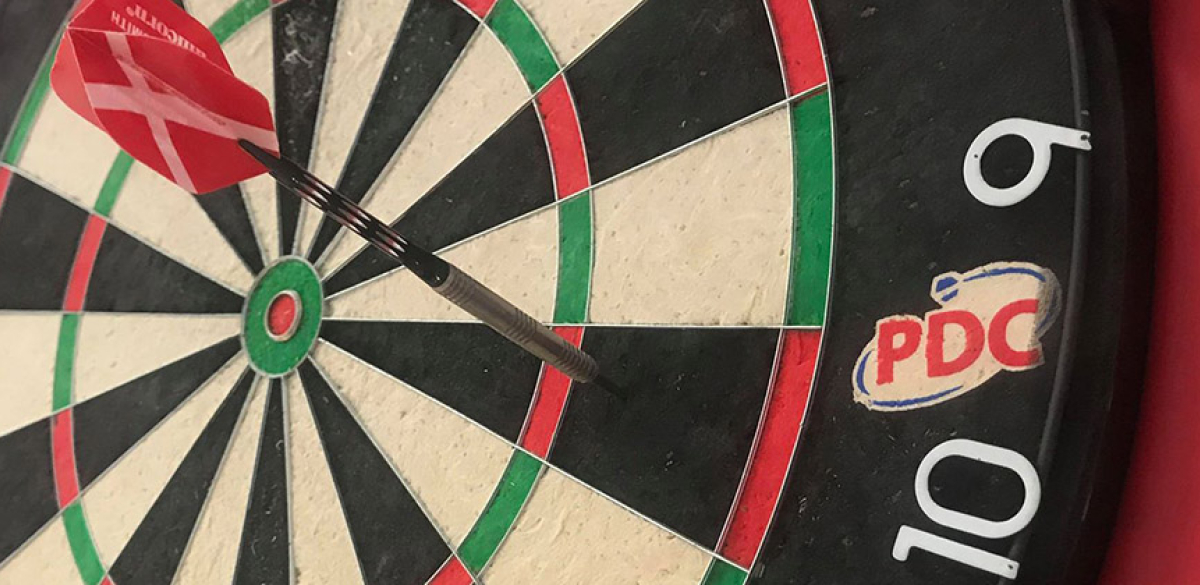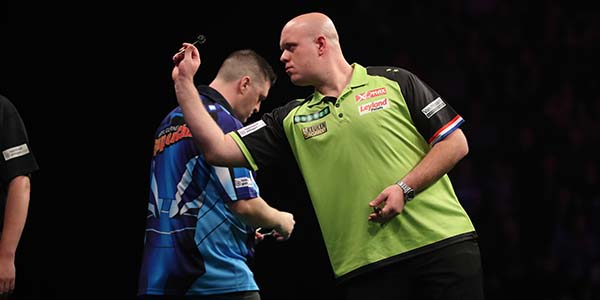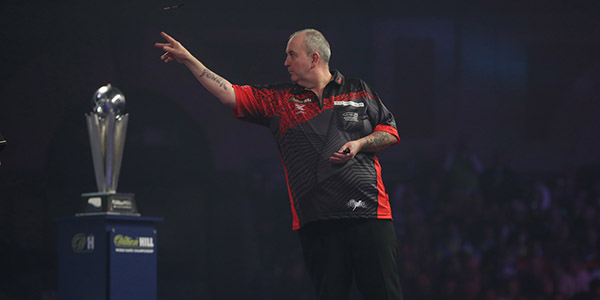
Christopher Kempf, the statistical analyst of the PDC, takes a look at why missing the 'big number' is easier than it looks.
It is perhaps one of the most famous and costly blunders in darts history.
Bobby George had a perfect opportunity to seize control of the 1980 World Championship final and pull even in sets against Eric Bristow by checking out with three darts from a score of 18.
His first dart at double nine was nearly closer to the treble than the double, and almost slipped into the single 14 - a nervy dart if ever there was one.
But that dart at double proved to be the last chance for George, as his second dart missed about three centimetres to the left of the single 1, busting his score and securing a first world title for the Bristow.

Reflecting on the historic match, George recalled his thinking in the moment: "In my mind, I said, 'Whatever you do, don't hit the 20!'".
A mere second later, "bang - straight in the middle" - seemingly no amount of mental reinforcement could prevent the missed double.
It seems almost incredible to see so many professionals miss the largest targets on the dartboard.
If most players have nearly a 25% probability of hitting the bullseye, a target not even 2cm² large, how can it be that there have been nearly 300 missed single numbers on stage to date in 2018?
A target 17 times larger than the bullseye should be almost unmissable from players who makes a living from their ability to hit targets from 7ft 9.75ins away.
But in fact, while professional players consistently miss 5% of their darts at the 'big numbers', no player can completely control the distribution of their darts around a given point sufficient to eliminate any missed single numbers.
It is, however, a test of a player's mental fortitude - even more so than of their accuracy or raw skill at throwing darts - to which players are subjected in such a situation as George's on that February night 38 years ago.
Only five of the 20 single numbers around the board represent the majority of attempts; single 20 alone is the subject of 23.6%, and together with 18, 9, 1, 17 and 14, it accounts for a majority.
On the other hand, single 4, which is only attempted by players attempting to leave 40 from 44, is hit in less than 0.75% of all legs played on stage in the PDC.
Not all singles are created equal, and a player who can reliably hit single 20 has won most of the battle when it comes to building a solid track record on the 'big numbers'.
Most common singles
Segment as a % of all singles attempted 2018 PDC-wide accuracy (stage)
Single 20 23.6% 94.6%
Single 18 9.0% 97.0%
Single 9 7.0% 94.7%
Single 1 4.7% 95.3%
Single 17 4.7% 96.4%
Least common singles
Segment as a % of all singles attempted 2018 PDC-wide accuracy (stage)
Single 16 1.6% 94.4%
Single 5 1.3% 98.7%
Single 11 1.3% 89.3%
Single 2 1.2% 94.2%
Single 4 0.9% 100%
It may come as a surprise, however, that players hit single 20 with less accuracy than they do on other singles on average - especially given the frequency at which players throw at the nearby treble 20 and double 20.
Throwing repeatedly at the treble 20 conditions many players to miss high and low rather than to the left and right, which could explain why singles 11, 13, 14, 9, 10 and 6 all have PDC-wide accuracy percentages at or well below the average for all single numbers (95.05%).
Players tend to miss these high or low, and rarely hit the nearby doubles or trebles.
The same is true for single 20 - the most common way to miss the single is by hitting the double 20, which may not even be much of an obstacle to a checkout - but there is also an additional factor at work.
Since more than two thirds of all darts in the game of 501 are aimed at treble 20, players aiming at single 20 must frequently navigate around blockers and avoid unexpected deflections.
Moreover, when players think ahead to an attempt at double 20 for a checkout with the next dart, they may also look to place the single below the centre of the bed to leave as much room for the final dart(s) as possible.
With all these factors to consider, hitting a single number suddenly presents a significant challenge.

That said, however, one would not expect the world number one, Michael van Gerwen, to be especially poor at hitting 'big numbers'.
Yet he is; he ranks 30th of the 42 players with the most attempts at singles in 2018.
The Dutchman has especially struggled on single 20 - for much of the year, more than 10% of his darts at that target were going astray.
His overall 5.16% probability of missing a 'big number' is worse than the PDC average and ahead of only Daryl Gurney amongst the PDC top 10.
For a player who, by his own admission, does not practice and does not aim, it is, perhaps, understandable why Van Gerwen would take little interest in hitting a target which must seem so enormous for a player of his ability.
| BIG NUMBER ACCURACY ON STAGE | |||
| All players with 40+ attempts, since December 2017 | |||
| Big numbers hit | Attempts | ||
| Phil Taylor | 56 | 56 | 100.00% |
| Brendan Dolan | 48 | 48 | 100.00% |
| Darren Webster | 87 | 88 | 98.86% |
| Jamie Lewis | 86 | 87 | 98.85% |
| Dimitri Van den Bergh | 83 | 84 | 98.81% |
| Kyle Anderson | 67 | 68 | 98.53% |
| Rob Cross | 297 | 302 | 98.34% |
| Dave Chisnall | 58 | 59 | 98.31% |
| Toni Alcinas | 54 | 55 | 98.18% |
| Adrian Lewis | 52 | 53 | 98.11% |
| Jelle Klaasen | 51 | 52 | 98.08% |
| Justin Pipe | 45 | 46 | 97.83% |
| Martin Schindler | 42 | 43 | 97.67% |
| Danny Noppert | 41 | 42 | 97.62% |
| Darius Labanauskas | 41 | 42 | 97.62% |
| John Henderson | 41 | 42 | 97.62% |
| Raymond van Barneveld | 142 | 146 | 97.26% |
| Mensur Suljovic | 202 | 208 | 97.12% |
| Peter Wright | 215 | 222 | 96.85% |
| Joe Cullen | 92 | 95 | 96.84% |
| Mervyn King | 88 | 91 | 96.70% |
| Gary Anderson | 236 | 245 | 96.33% |
| Ian White | 77 | 80 | 96.25% |
| Cristo Reyes | 50 | 52 | 96.15% |
| Jonny Clayton | 69 | 72 | 95.83% |
| Kim Huybrechts | 46 | 48 | 95.83% |
| Michael Smith | 181 | 189 | 95.77% |
| James Wade | 125 | 131 | 95.42% |
| Keegan Brown | 40 | 42 | 95.24% |
| Simon Whitlock | 154 | 162 | 95.06% |
| Michael van Gerwen | 331 | 349 | 94.84% |
| Steve West | 104 | 110 | 94.55% |
| Jermaine Wattimena | 85 | 90 | 94.44% |
| Max Hopp | 98 | 104 | 94.23% |
| Steve Lennon | 61 | 65 | 93.85% |
| Gerwyn Price | 178 | 190 | 93.68% |
| Daryl Gurney | 176 | 188 | 93.62% |
| Chris Dobey | 41 | 44 | 93.18% |
| Stephen Bunting | 49 | 53 | 92.45% |
| Vincent van der Voort | 43 | 47 | 91.49% |
| Paul Nicholson | 53 | 58 | 91.38% |
| Alan Norris | 39 | 43 | 90.70% |
| Steve Beaton | 41 | 46 | 89.13% |
On the other hand, consider Rob Cross' superb 98.34% accuracy on the singles - missing one 'big number' for every 60 successful hits (on TV and with thousands of pounds on the line), and only five out of 302 attempts, is an incredible achievement of focus and calmness under pressure.
There is nothing to lead us to believe that Cross is a more accurate player in general at hitting different targets - Van Gerwen leads Cross in their treble, double and bullseye percentages - but there may be something different about their mental outlooks.
The high percentages of players such as Darren Webster (one miss in 88 attempts) and Brendan Dolan (zero misses in 48 attempts) show that some players are better equipped to dispel their own darts and maintain composure when their minds are full of the thought, "Whatever you do, don't miss the big number!"

Inconclusive evidence suggests that Phil Taylor, as in many other respects, was the master of these shots.
He secured his legacy with a clinical performance in his final World Championship: 56 darts thrown at single numbers, 56 successful hits.
In the long run, no one is perfect on the 'big numbers', and eventually the anxiety over missing them sets in.
But an opponent who sees a player string together 50, 75, or even 100 legs without a 'big number' error, waiting in vain for a mistake, will inevitably become demoralised.